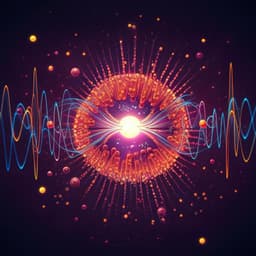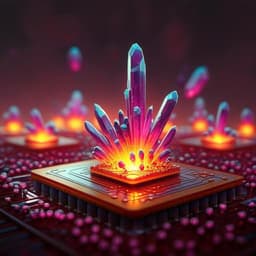
Physics
Electronic transport driven by collective light-matter coupled states in a quantum device
F. Pisani, D. Gacemi, et al.
Dive into the groundbreaking research by Francesco Pisani and colleagues as they unveil a quantum infrared detector that thrives in the ultra-strong light-matter coupling regime. This study paves the way for the next generation of optoelectronic devices, enhancing quantum cascade detectors through coherent electron-photon interactions.
~3 min • Beginner • English
Introduction
Light–matter interaction depends critically on the electromagnetic environment. In dense ensembles, emission/absorption can be enhanced via Dicke superradiance. In semiconductor quantum wells (QWs) with a dense 2D electron gas, Coulomb interactions synchronize electronic oscillations into intersubband plasmons that, when coupled to a resonant microcavity, hybridize with cavity photons to form intersubband polaritons split by 2ħΩR. This collective strong/ultra-strong coupling can modify fundamental material properties and enable new device functionality. However, conventional bosonic models that treat matter excitations as harmonic oscillators track energies of collective modes but not electronic population dynamics, and their Hilbert space is orthogonal to the single-particle sector that carries current. The practical question is how to efficiently couple single-particle fermionic transport to bosonic collective polaritons, especially when strong coupling renormalizes polariton energies away from bare transport levels. The authors address this by experimentally and theoretically studying quantum cascade detectors (QCDs) where a single-particle extractor level is tuned into resonance with collective light–matter states, and by developing a microscopic, fermionic quantum model linking subband populations to collective polarizations via nonlinear Bloch-type equations.
Literature Review
The study builds on decades of work on superradiance (Dicke), intersubband transitions in QWs, and intersubband polaritons in microcavities from THz to MIR. Prior bosonized models (e.g., dipole gauge treatments) effectively capture polariton energies and Rabi splittings but neglect carrier population dynamics central to transport. Strong/ultra-strong coupling has been shown to impact conductivity, chemical reactivity, topology, and nonlinear optics, and devices such as polaritonic QCLs/detectors have been demonstrated. Conventional QCD theory treats extraction probability and absorption independently, often adding phenomenological electronic filters. Recent works have reported strong coupling in QWIPs and hints of polariton-assisted tunneling. The present work departs from bosonization by explicitly modeling fermionic populations and coherences and their coupling to cavity photons and collective plasmonic shifts, thereby providing a microscopic link between collective polaritons and single-electron transport.
Methodology
Devices: The absorbing region comprises 11 periods of four GaAs QWs separated by Al0.35Ga0.65As barriers. Photons excite electrons in an 8.8 nm wide QW from subband 1 to 2 (single-particle E21 = 108 meV). Electrons then cascade through levels 3, 4, 5 to the next period. The Fermi level is 96 meV above level 1, yielding a sheet density ~2.6×10^12 cm^-2 and plasmon energy ħωp = 70 meV causing strong collective effects. Mesa and multipass structures were first characterized by absorption and photocurrent. Strong coupling implementation uses double-metal microcavity arrays with ribbon width w setting cavity energy Ec ≈ K hc/(neff w) (K=1 fundamental mode). The field is strongly confined within the semiconductor. Arrays were fabricated with ohmic contacts (Pd/Ge annealed), ICP etching to leave active region beneath ridges only; detector area ~100×100 μm^2. Reflectivity was measured with FTIR (TM/TE normalization) and simulated via COMSOL. Photocurrent spectra were recorded for multiple Ec and under applied bias to tune E13 via band bending.
Microscopic model: A Hamiltonian includes (i) cavity photons (a, a†), (ii) single-particle electron subbands, (iii) collective polarization operator P12 = Σk(c2k† c1k + h.c.) with dipole–dipole interactions producing plasmonic blue-shift (E12 = E21 + ħωp), (iv) light–matter coupling between cavity field and P12 with coupling Ω12 ∝ √(ωp/2)×F/E21 (F≈0.13 overlap factor), and (v) tunneling between levels 2 and 3 with strength ħΩt (Ωt ≈ 4.7 meV). The 1→3 transition has negligible oscillator strength; the 1→2 transition is collectively enhanced and couples to the cavity. Dynamics are treated with a density-matrix approach at T=0 K, including relaxation terms for populations Ni and coherences ρij, and driven by an external field Sin coupled to the cavity (or directly to electrons for mesa). The resulting nonlinear Bloch-type equations (including quadratic and anti-resonant terms) are solved in steady state to obtain intracavity field and coherences. Photocurrent is Iph = e N3/τ34, with N3 derived from time-averaged products of the intracavity electric field and coherences. In the linear (low-power) regime, the detector responsivity is R(ħω) = e/[ħω Np] × Ge × G1(ħω) × η(ħω), where η(ħω) is the total absorption efficiency of the active region; Np is the number of periods; Ge = 1/(1+τα/Teff) is the extraction probability dependent on tunneling alignment between levels 2 and 3 (τα from detuning Δ23 and dephasing γ23), and G1(ħω) is a coherent gain arising from transport-related coherences coupling to the collective polarization. An approximate form is G1(ħω) ≈ [1/(1+16 ω21^2 γ12 γ13 γ32)] × [1/(1+((ω−ω31)/γ31)^2)], highlighting a resonance near the extractor transition ω31 and dependence on coherence quality factors. Parameters fitted from experiment: ħγ23 = 2 meV, ħγ13 = 16 meV, ħγ12 = 5 meV. Bias-dependent measurements adjust E13 by applied voltage to test model predictions.
Key Findings
- In mesa/multipass characterization, the absorption peak is blue-shifted from the single-particle E21 = 108 meV to the collective intersubband plasmon energy E12 ≈ 130 meV (E21 + ħωp with ħωp = 70 meV). The photocurrent spectrum is further shifted toward the extractor transition E31 = 145 meV, showing asymmetric spectral response consistent with transport driven by the collective excitation.
- Strong coupling in double-metal cavities is achieved with Rabi splitting 2Ω ≈ 22 meV at 80 K, about 17% of the transition energy, evidenced by UP/LP in reflectivity. Calculated η(ħω) confirms tunability of polariton energies around E13.
- Photocurrent spectra across multiple cavity energies Ec are accurately reproduced by the microscopic model, including integrated photocurrent versus Ec. The photocurrent is maximized when the upper polariton (UP) aligns with the extractor transition (EUP ≈ E13), despite the LP/UP dispersion remaining unchanged.
- The responsivity can be expressed as R(ħω) = e/[ħω Np] Ge G1(ħω) η(ħω). Ge is the conventional extraction probability dependent on alignment of levels 2 and 3 and independent of photon energy. The additional coherent gain G1(ħω) strongly shapes the spectra and peaks near ω ≈ ω31; it arises from coherence ρ13 induced by tunneling Ht and driven by collective polarization ρ12. Removing ρ13 (forcing γ13 → large) collapses the photocurrent spectral shape to η(ħω), inconsistent with measurements.
- Fitted dephasing/relaxation parameters: ħγ23 = 2 meV, ħγ13 = 16 meV, ħγ12 = 5 meV.
- Bias tuning shifts E13 from 145 meV (0 V) down to 117 meV (0.35 V), modifying relative UP/LP photocurrent amplitudes; when E13 resonates with LP at positive bias, LP photocurrent increases, as captured by the model.
- Strong vs weak coupling: Simulations show that in strong coupling (ħωp = 70 meV) the maximum responsivity occurs when G1(ħω) maximum coincides with a polaritonic absorption maximum (often the LP), enabling polariton-induced transport and enhanced responsivity beyond conventional expectations. In weak coupling (ħωp = 7 meV), maxima coincide with the bare intersubband transition independently of extractor position, and conventional theory (G1 = 1) matches the full model.
- The product ω21 ω23 ω31 in G1 and its dependence on γij reveal a nonlinear rectification mechanism akin to nonlinear optics, converting AC optical drive and coherences into DC current via the nonlinear Maxwell–Bloch dynamics in the fermionic system.
Discussion
The study directly addresses how single-particle fermionic transport can be efficiently coupled to bosonic collective polaritons in QW-based detectors. By developing and validating a microscopic fermionic model, the authors show that transport is governed not only by absorption and conventional extraction probability but also by a coherent gain G1(ħω) arising from tunneling-induced coherence ρ13 driven by the collective polarization ρ12. This mechanism explains the asymmetric blueshifted photocurrent in mesas and the alignment-dependent photocurrent enhancement in microcavities: maximal photocurrent occurs when a polaritonic resonance (LP or UP) aligns with the extractor transition energy, enabling efficient population of level 3 via both indirect (1→2→3) and direct (1→3 assisted by collective polarization) pathways. The findings provide design principles for polaritonic optoelectronics: engineering extractor level energies to coincide with polariton energies and optimizing coherence quality factors can enhance responsivity. In strong coupling, the interplay of increased η(ħω) at polariton energies and the resonant G1(ħω) yields polariton-induced transport beyond conventional QCD expectations, whereas in weak coupling conventional behavior is recovered. This unifies collective light–matter physics with fermionic transport and offers a quantitative tool for device optimization.
Conclusion
The paper demonstrates that collective light–matter coupled states (intersubband polaritons) can drive and enhance electronic transport in quantum detectors. A microscopic fermionic Hamiltonian and density-matrix model, free from bosonization, quantitatively reproduces photocurrent spectra and identifies a coherent gain term G1(ħω) linking collective polarizations to extractor-level population. Experiments on GaAs/AlGaAs QCDs in double-metal microcavities show strong coupling with 22 meV Rabi splitting and photocurrent maximization when polariton energies align with the extractor transition; bias tuning of E13 confirms model predictions. The work establishes design guidelines for polariton-assisted detectors and suggests broader applications where collective states are leveraged for transport. Future research directions include: (i) fully quantum treatments to capture vacuum-field-induced transport modifications; (ii) replacing discrete extractors with continua to model strongly coupled QWIPs; (iii) extending to higher-density, multi-subband systems and engineered plasmonic confinements; and (iv) exploring whether polariton-induced responsivity can exceed resonant extraction limits to realize low-dark-current, higher-temperature detectors.
Limitations
The theoretical treatment is semi-classical for the light field (coherent state factorization) and assumes T = 0 K in the density-matrix dynamics; vacuum-field fluctuations and higher-order light–matter correlations in the ultra-strong regime are not included but are proposed for future work. Parameter extraction relies on fits (γij, tunneling strengths), and the optimal alignment of E13 is constrained by barrier heights to avoid coupling to the continuum. Results are demonstrated in specific GaAs/AlGaAs QW heterostructures and microcavity geometries; generalization to other materials and device architectures, while plausible, remains to be validated experimentally.
Related Publications
Explore these studies to deepen your understanding of the subject.







